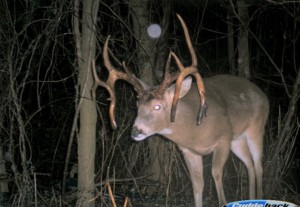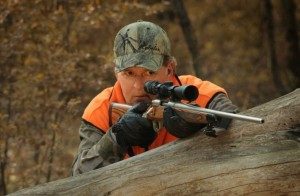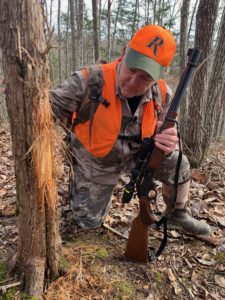 Last November 13, I saw and heard deer crashing through the woods everywhere. The next day I sat in the same stand and saw 10 squirrels and one fork-horn. What happened?
Last November 13, I saw and heard deer crashing through the woods everywhere. The next day I sat in the same stand and saw 10 squirrels and one fork-horn. What happened?
You were hunting just as “lockdown” began. That’s the mini-phase when the older bucks hook up with the older does to breed, and they all seem to go underground for three or four days. To punch your tag during that phase this fall, head for your best stand or blind deep in the timber and hunt there all day for several days. Ideally you’ll have a commanding view of several thickets on ridges and in draws, ditches and/or creek drainages. A doe might pop out of a cover; an 8- or 10-pointer might bust out and herd her back in. Subdominant bucks will sneak around the thickets, hoping to get in on some of the action. Or you might spot a toad 9-pointer skulking from one cover to the next; he just bred one gal is trolling for another. Hunt long and hard and you’ll see a shooter.
I find dozens of scrapes on my land each fall, but I never seem to hunt the right ones. Which should I watch?
Try setting up in a stand where you can cover the last big, fresh scrapes that peter out 50 yards or so from a swamp, thicket, clear-cut, etc. where you believe bucks are bedding. Those are the last scrapes an 8-pointer will walk past as he sneaks back to bed at first light. They are the first ones he’ll pass as he prowls out of the cover at dusk. He might linger awhile in shooting light around those scrapes so close to his sanctuary. You might see him and shoot him.
What is the best sign to find during peak rut?
Shredded rubs as thick as your calf and smoking scrapes tell you a big boy or two is working your area, but don’t fall into the trap of hunting too hard on that sign. We think a long, winding doe trail trampled down to bare, muddy ground is better. Set up downwind, watch it long enough and a giant is apt to show, either marching smack on the trail or circling on the downwind side (close to your stand) and scent-checking for does that recently walked on the path. The thicker the cover and the more rubs and scrapes that line the trail, the better.
Should I hunt the edge of a food plot or a trail that leads into it in early November?
Try hunting 100 yards or so back in the woods, along the thickest, nastiest funnel that leads to and from a food source. That’s where a big-racked deer will rut around most of the time in shooting light.
I get bored sitting in a stand or blind. Is stalking the rut an option?
Sneak 30 yards…lean against a tree…glass and listen…slip another 20 yards…look… We’ve smoked a bunch of rutting bucks that way. But we only do it on a property with very light hunting pressure. You want to still-hunt without worry of bumping into a stranger, or driving an 8-pointer into his sights.
Stalking has several advantages. You cover a lot of ground, which increases your odds of encountering more bucks trolling for does. The more you move, the more rubs, scrapes and big tracks you’ll find in out-of-the-way spots. You might come back tomorrow, hang a stand in a hot spot that nobody else knows about and shoot the big boy that is putting down that sign. Some sneaky tips:
- Stalk after a rain or light snow, when it’s quiet in the woods. You might have a 10 to 20 mph wind as the front passes—good because it covers your moves.
- Stay high on ridges and hillsides, but don’t skyline. Move slowly, pause beside trees and watch for deer in funnels and bottoms below.
- Use a wind-checker and keep the breeze quartering on or across your face.
- Use your nose. Rutting bucks reek of tarsal and you can sometimes smell one.
I’ve heard that hunting near a bedding area is a good morning tactic? How should I do it?
It’s an awesome strategy for the rut, but you’ve got to be smart and deliberate. Start off with a tree stand 150 yards or so downwind of a bedding cover in a good observation area. Set up where you can see well, but near a trail or funnel where you have a fighting chance of shooting a buck that cruises by. Watch and pattern the deer as they enter and leave the bedding site for a day or two, then move your stand left, right or closer for an ambush (a mobile, quick-to-move climber works great). You might have to reposition two or three times to kill a good buck, especially with your bow. Take it little jumps at a time and make sure the wind is good every day.
The spot I hunt is only 60 acres, mostly hardwoods with a thick creek bottom on the south end. I’m off the second week of November . Where should I hunt?
First off you’ve picked a great week—sex-starved big boys are prowling, but most of the gals aren’t ready to breed yet. Post on a ridge or bench that overlooks the creek thickets. Hunt all day—it is full-moon, and some deer will move at midday. The bad news: Most of the bucks that frequented your small spot in October will leave for a while—you might see them in a corn field or chasing a doe across a road two miles away. The good news: While they’re gone a gargantuan 10-pointer you’ve never seen before might pop up in the creek bottom to check the does on your spot. Sooner or later one of those 8-pointers you bowhunted last month will swing back through his core area in search of a gal. Either way you win because you sat tight and hunted your spot wisely.
I saw a monster 9-pointer cruising for does on a ridge this morning, but he was 100 yards too far for a muzzleloader shot. Should I move my stand or sit tight and hope he comes within range later in the week?
Tough call, but generally it pays off to pick up and move to a spot where a buck you see a buck blazing rubs, digging scrapes or dogging does right now. In most regions, November first to the 20th is the time to get aggressive. With bucks smashed on testosterone, you still need to play the wind and be smart. But you can get away with more noise and movement than usual as you reposition in the middle of the action. Remember that conditions change fast (1.e. a doe a mile away might pop into heat overnight and pull all the bucks to her, or a hunter might move in on your spot). If you don’t go for the kill when you can, you might never see that hoss buck again.
I hunt a lease with 20 other guys, and it’s hectic the first week of rifle season. Where should I hunt?
Missouri biologist Dr. Grant Woods has done extensive geographic analyses of hunting properties across the U.S. Not surprisingly, he finds that most people hunt within a quarter-mile or so of logging roads, ATV trails or crop fields. The other 90 percent of a property is a potential “de facto deer sanctuary, and somewhere in there is where you need to go,” he says. Take a red Sharpie and mark on an aerial where other people hunt. Then check out thick, rough, off-beat spots a half-mile or farther from those roads and fields. Hang a tree stand in one of the “buck holes” where the access is manageable and where the north to west wind will be okay most days. Not if but when a good buck dives in there to escape the pressure, you’ll be waiting on him.
Is it true that I should pass up the first buck that chases a doe past my stand because a bigger one is coming?
One day in Illinois, a skinny doe ran beneath veteran bowhunter Dan Perez’s stand. He drew on the first buck that dogged her, a big 8-pointer, but held his fire. Seventeen more bucks churned by! He hoped for a shot at the 195-inch giant that brought up rear, but no cigar. He galloped by at 30 yards, but too fast. It can be like that in early November. One of the first hot does will attract multiple bucks (though usually not 17). You might be choosy then. Later on toward peak rut when most does are in estrus, things have shuffled out in the buck hierarchy; a dominant buck is often the first and only boy you’ll see with a doe. But it’s always a tough call. We say that if the first buck that lopes by looks big and makes you happy, take him.
You hear a lot about “signpost” rubs. How important are they in mid-November?
Although only older bucks shred trees the size of your thigh, most deer interact with the signposts. They look at them, lip-curl and smell of them and sometimes walk up to touch and rub them. They become communal pheromone wicks. Bucks build signposts in spots that get high deer traffic—cover edges, hogback ridges, creek bottoms, narrow strips of timber near food plots and the like. While we don’t hunt over big rubs per se, we set a lot of stands and blinds in funnels where we find a lot of fresh ones.
I’m swamped at work this fall and will only be able to hunt a couple of weekends in late November. Got any advice?
Here’s one of our best and simplest tactics when we’re strapped for scouting and/or hunting time. Check an aerial or topo of a public area for an out-of-the-way creek drainage. Pack a climbing stand on your back and hike a mile or two up the creek. Search for a shallow, narrow, gently sloping trail crossing pocked with a lode of tracks and hopefully at least one set of long, wide buck prints in the mud. Run your climber up a tree 50 or 60 yards downwind of the pinch point and sit all day, all weekend. You will see some deer and maybe a shooter on the prowl for a last hot gal. Heck, you might shoot a buck bigger than the ones your buddies got who took two weeks off work.
Will the buck I bowhunted all October still be on my property in November?
Nearly all 3.5-year and older bucks expand their home ranges and daily movements in November, making them less predictable to reappear in spots where you saw them in September and October. Tennessee researcher Bryan Kinkel’s extensive census studies show that the “rut shift” starts about three weeks before peak breeding and can be like clockwork every year.
While the bucks you hunted in October will go AWOL for a time in November, you’ll pick up vagabonds widening their range and contacting as many does as they can. Kinkel notes that the “new” bucks won’t stay on your land every day, but they’ll drift through from time to time. You never know when and where they’ll show up. Just hang tight in your best morning stands on ridges and in hollows laced with rubs and scrapes. There’s a good chance you’ll bust a buck you’ve never seen before.
Does hot weather really knock back the rut?
Deer still chase and breed from roughly November 7 through the 20th in most regions, but during a hot spell (60s or 70s) they do it mostly during the cool nights. While you won’t see as many deer moving during the day, stay out there man. Try this. Pull out of your best morning stands deep in the timber. That’s where deer will rut the best when it cools off, so don’t burn those spots out now. Move to an evening stand or blind nearer to a crop field, clover plot, acorns, etc. There you’ll see does and maybe a shooter on his feet and dogging them when it cools off at dusk.
Should I hunt the rut in the mornings or the afternoons?
It depends when you’re off work this fall, according to Iowa big-buck expert Mark Drury. During the first week of November and the first-quarter moon, he anticipates good deer activity around food sources in the evenings. When the moon waxes to full from the 5th through the 11th “hunt your best ridge and funnel stands in the mornings, and you’d better stay in them until lunchtime,” he says. Drury notes that the cooler it is, the more bucks you’ll see trolling and chasing in the mornings and at midday through the 20th. High-pressure days with a rising barometer and temperatures from 35 to 49 are prime.






